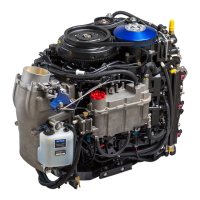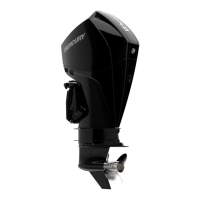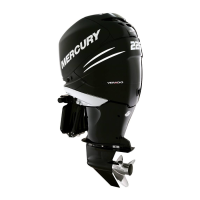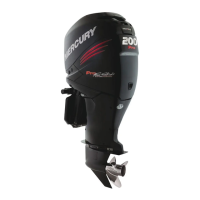Exhaust Emission Standards
Through the U.S. Environmental Protection Agency (EPA), the federal government has established exhaust emissions
standards for all new marine engines sold in the U.S.
What Are Emissions?
Emissions are what come out of the exhaust system when the engine is running. They are formed during the chemical process
of combustion from the elements that are present in the combustion chamber. Some emissions are harmless, while others can
be harmful to people or the environment. The U.S. EPA regulates potentially harmful emissions.
Engines manufactured by Mercury Marine reduce the emissions of certain pollutants, and potentially harmful gases in the
exhaust to conform with levels legislated by the U.S. EPA. Standards are set primarily with regard to three types of emissions:
hydrocarbons (HC), carbon monoxide (CO), and oxides of nitrogen (NOx).
Hydrocarbons – HC
Gasoline is a hydrocarbon fuel. Two elements of hydrogen and carbon are combined with oxygen and burned during the
combustion cycle. Some residual elements pass through the combustion chamber and exit the exhaust system as unburned
gases known as hydrocarbons.
Carbon Monoxide – CO
Carbon is one of the elements that make up the fuel burned in the engine along with oxygen during the combustion process. If
the carbon in the gasoline could combine with enough oxygen (one carbon atom with two oxygen atoms), it would come out of
the engine in the form of carbon dioxide (CO
2
). CO
2
is a harmless gas. Carbon often combines with insufficient oxygen (one
carbon atom with one oxygen atom), forming carbon monoxide (CO). Carbon monoxide is the product of incomplete
combustion and is a dangerous, potentially lethal gas.
Oxides of Nitrogen – NOx
NOx is a slightly different by‑product of combustion. Nitrogen is one of the elements that makes up the air going into the
engine. Under extremely high temperatures it combines with oxygen to form oxides of nitrogen (NOx). This happens in the
engine's combustion chambers when temperatures are too high. NOx itself is not harmful, but when exposed to sunlight it
combines with unburned hydrocarbons to create the visible air pollutant known as smog. Smog is a serious problem in
California as well as many other heavily populated areas of the United States.
Controlling Emissions
There are two principle methods of reducing emissions from a four‑stroke marine engine. The first method is to control the air/
fuel ratio that goes into the combustion chamber. The second is to control the time when this air/fuel mixture enters the
combustion chamber. Timing is important, to prevent any unburned mixture from escaping through the exhaust.
Stoichiometric Ratio (14.7:1) Air/Fuel Ratio
Engineers have discovered that pollutants and exhaust emissions can be reduced if a gasoline engine operates at an air/fuel
ratio of 14.7:1. The technical term for this ratio is stoichiometry, or stoichiometric ratio. An air/fuel ratio of 14.7:1 provides the
best control of all three elements in the exhaust under almost all conditions. The HC and CO content of the exhaust gas is
influenced significantly by the air/fuel ratio. At an air/fuel ratio leaner than 14.7:1, HC and CO levels are low, but with a ratio
richer than 14.7:1, they rise rapidly. It would seem that controlling HC and CO by themselves might not be such a difficult task;
the air/fuel ratio only needs to be kept leaner than 14.7:1. However, there is also NOx to consider.
As the air/fuel ratio becomes leaner, combustion temperatures increase. Higher combustion temperatures raise the NOx
content of the exhaust. Enrichment of the air/fuel ratio to decrease combustion temperatures and reduce NOx emissions will
increase HC and CO emissions and adversely effect fuel economy. The solution to controlling NOx, HC, and CO ‑ is to keep
the air/fuel ratio as close to 14.7:1 as possible.
Emissions Information
Manufacturer's Responsibility
Beginning with 1998 model year engines, manufacturers of all marine propulsion engines must determine the exhaust emission
levels for each engine horsepower family and certify these engines with the United States Environmental Protection Agency
(EPA). A certification decal/emissions control information label, showing emission levels and engine specifications directly
related to emissions, must be placed on each engine at the time of manufacture.
Dealer Responsibility
When performing service on all 1998 and newer outboards that carry a certification, attention must be given to any adjustments
that are made that affect emission levels.
Adjustments must be kept within published factory specifications.
Emissions
Page 1C-2 © 2018 Mercury Marine 90-8M0146617 eng JULY 2018

